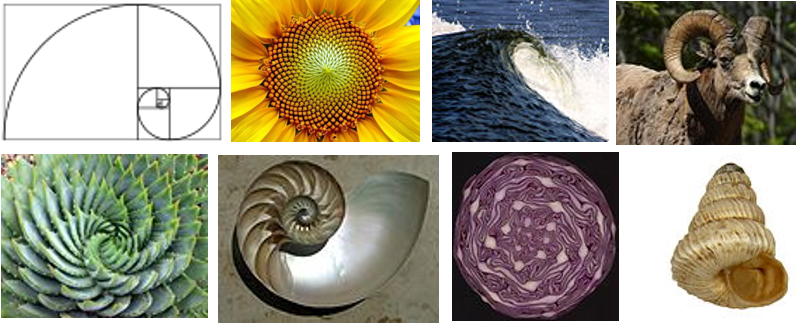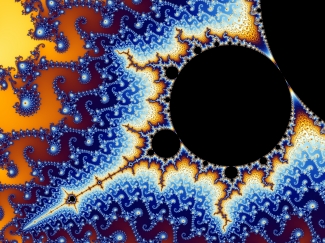This week I thought I’d collect together examples of two of my favourite things colliding: nature and maths! Patterns are everywhere around us, you have only to look 🙂
I hope the beauty displayed below inspires people to create some of these or see them in nature for yourself – and in doing so, you’ll be unwittingly maths-ing!
Bezier curves are straight lines positioned at slightly different angles to give the appearance of a curve. I remember making these with my sisters, using either just a pen and ruler, or nails and string stretched between them. You can start simple, or if you have the patience you can even create an owl!:
Polyhedra are 3D solids with flat faces and straight edges, with cubes and pyramids being simple examples. The word polyhedron comes from Greek πολύεδρον, poly- (stem of πολύς, “many”) and -hedron (“base”). There are some beautiful regular polyhedra…

…and irregular polyhedra can also be found in nature in the form of crystals and viruses:

Tesselations: geometric shapes can also often be tesselated – where patterns are formed by repeating tiles all over a flat surface. While common in art and design, exactly repeating tilings are less easy to find in living things – hexagonal interlocked honeycombs are perhaps the best-known example:
Amongst animals, tesselation can be seen in fish and reptiles with overlapping scales that form repeating units (though often the scales vary in size), and in non-living formations such as Giants Causeway, with interlocking hexagonal stone columns:

Symmetry is common in animals (mainly bilateral or mirror symmetry), and plants (their leaves and some flowers often have radial or rotational symmetry). It has a variety of causes in nature. Radial symmetry suits organisms like sea anemones whose adults do not move: food and threats may arrive from any direction. Animals that move in one direction necessarily have upper and lower sides, head and tail ends, and therefore a left and a right – their bodies become bilaterally symmetric. More complex is the reason for the fivefold symmetry of the echinoderms e.g. starfish, sea urchins, and sea lilies. Among non-living things, snowflakes have striking sixfold symmetry: each flake is unique, its structure forming a record of the varying conditions during its crystallisation, with nearly the same pattern of growth on each of its six arms.

Bilateral symmetry on a tiger; Starfish with fivefold symmetry; Snowflakes have sixfold symmetry; sea anemones and Saturn display rotational symmetry
Patterns formed from waves: Leopards and ladybirds are spotted; angelfish and zebras are striped. Orchids, hummingbirds, and the peacock’s tail have abstract designs with a beauty of form, pattern and colour that artists struggle to match. In plants, the shapes, colours, and patterns of insect-pollinated flowers like the lily have evolved to attract bees and others.

Symmetry: peacock, Royal Angelfish, ladybird, hummingbird, and lily
Such patterns have an evolutionary explanation: they increase the chances that the offspring of the patterned animal will survive to reproduce, e.g. camouflage (a leopard that is harder to see catches more prey) and signalling (an insect is less likely to be attacked by predators if it has bold warning colours that indicate its poisonous / dangerous nature). But to see how the patterns are formed in the first place, we again look to maths. Alan Turing described how “reaction-diffusion equations” might be used to generate patterned structure during their development as an embryo. Pigmentation results from the feedback loop of the production of the chemical signal (“morphogen”) being turned on, then off when it reached a certain level by “inhibitor” chemicals, in continual waves as it diffuses around the body during growth. Researchers have modelled on this basis to give patterns as diverse as zebra stripes, giraffe blotches, jaguar spots and ladybirds.

Dirce Beauty butterfly; Zebra; Leopard; Detail of Giant pufferfish skin pattern; Guinea fowl
The Fibonacci Sequence is 1, 1, 2, 3, 5, 8, 13… , where each number is the sum of the two preceding ones. It occurs in nature when criss-crossing spirals produce an optical effect, like the florets of a sunflower, and the number of florets always turn out to be Fibonacci numbers! A similar effect can be seen in the arrangement of leaves on a stem, and in the arrangement of fruit structures like the pineapple and snake fruit, as well as in the pattern of scales in pine cones, where multiple spirals run both clockwise and anticlockwise. For example, when leaves alternate up a stem, one rotation of the spiral touches two leaves, so the pattern or ratio is 1/2. In hazel the ratio is 1/3; in apricot it is 2/5; in pear it is 3/8; in almond it is 5/13. In animals, for example in the nautilus mollusc, each chamber of its shell is an approximate copy of the next, scaled by a constant factor and arranged in a spiral:

Fibonacci spiral; sunflower seeds; wave; Bighorn sheep; Spiral aloe; Nautilus shell’s logarithmic growth spiral; Multiple Fibonacci spirals: red cabbage in cross section; Gastropod mollusc shell
Fractals are infinitely self-similar, iterated (repeating) geometric constructs – no matter how far you zoom in, the shape is still the same. They can be found in many natural occurrences, in phenomena as wide as river networks, mountain ranges, lightning bolts, DNA, clouds, geologic fault lines, coastlines, snow flakes, crystals, blood vessel branching, and ocean waves. Infinite iteration is not possible in nature so all ‘fractal’ patterns are only approximate; e.g. the leaves of ferns are only self-similar to 2, 3 or 4 levels.
 Romanesco broccoli; Angelica flowerhead; blood vessels; fractal river formation
Romanesco broccoli; Angelica flowerhead; blood vessels; fractal river formation
A particular example of fractals is a Mandelbrot set: images made by sampling complex numbers and determining for each whether the result tends towards infinity when a particular mathematical operation is iterated on it. Treating the real and imaginary parts of each number as image coordinates, pixels are coloured according to how rapidly the sequence diverges, if at all. The name is in tribute to the mathematician Benoit Mandelbrot. It has become popular outside mathematics for its aesthetic appeal:

Finally, the pattern of music is beautiful. We already know music can sound beautiful, but also now Nicholas Rougeux has beautifully visualised it too – this is Vivaldi’s Four Seasons:







Leave a comment